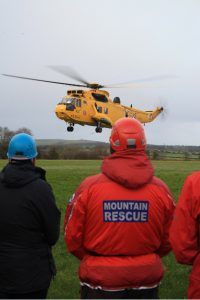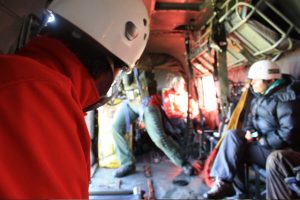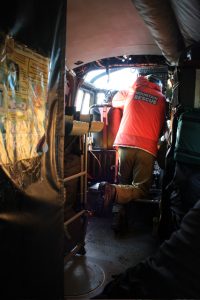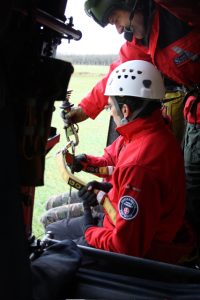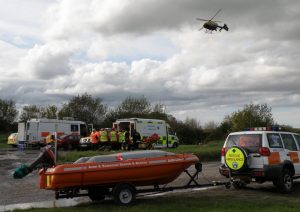Multi-agency Cave Rescue Led by A&S SAR Member
The following letter is from a Scout Leader rescued from a cave by an A&S SAR member, last February, operating in his role as a Great Western Ambulance Service (GWAS) co-responder at the time. The rescue involved a local caver, GWAS HART (Hazardous Area Response Teams) and a GWAS paramedic. This shows how volunteers regularly operate alongside full-time emergency service colleagues to help the public.
Dear Mark and the Rescue team,
I’d just like to make my gratitude known to the rescue team. I was rescued on February 12th in Sidcot Swallet (I think) while caving with my Scout group and the very experienced and exceptionally trained members of the West Sussex County Caving Team. I suffered a nasty knee dislocation whilst pushing through a squeeze. I wedged myself in the squeeze and stayed there with my knee still dislocated for about an hour. A very helpful cave leader from an unrelated group to my group helped me through the squeeze after my knee naturally relocated after I’d relaxed. Although i was in the cave for many hours i would like to thank the rescue teams that came to my aid.
Without them the situation could have been a lot worse, luckily I didn’t dislocate my knee in the lobster pot because that would have been almost impossible.
Thank you for your swift, effective and amazing rescue (and for giving me an interesting story to tell). I am very grateful and intend to make caving one of my more regular hobbies.
My knee is recovering very well and physiotherapy will ensure that it won’t happen again.
When my knee is fully functional i am organising a fund raising event, a 50km hike over the South Downs. All of the money raised will be donated to the rescue teams, as a ‘thank you’ for helping me when i was in a very bad state.
Once again, thank you for the rescue and the help and support that was given in the cave from the point of cave rescue making contact with me, to me being put in an ambulance and being taken to hospital.
Your’s gratefully,
Alastair Barnes,Young Scout Leader 1st/9th Horsham Scout Group
Posted on 03 / 01 / 2012
RAF Sea King Training
Over the Christmas holiday an RAF Search and Rescue Sea King helped members of A&S SAR with their familiarisation training for involving helicopters in rescues. SR169 from 22 Squadron flew to the Mendip Hills to help train team members, then A&S SAR provided two ‘climbers’ for the crew to practice winching in Cheddar Gorge.
The familiarisation training involved A&S SAR members understanding how to safely enter and exit the aircraft, being winched, what to do inside and what to do in the event of an emergency. Most importantly team members experienced the sensation of the Sea King coming in to land next to you, this helps forewarn and protect any casualty from the noise and wind.
A&S SAR thanks the crew of SR169 for the training and experience.
Posted on 02 / 01 / 2012
Working Together
This image shows the planning stage during the recent call-out, Log No 1024, at Huntspill, Bridgwater. Police helicopter and dog teams along with the Burnham hovercraft, Coastguard and RNLI all worked together to try and successfully resolve the situation.
Our thanks to Bunrnham-On-Sea.com for allowing us to use this image. To read their full write up click here
Posted on 04 / 11 / 2011
Working with Search & Rescue Helicopters
A new document has been published by the RAF to help consolidate and provide additional information on Working with Search and Rescue Helicopters. This Pdf is available to download free of charge. This has been put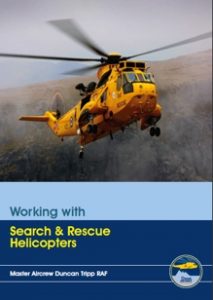 together as an additional resource for all in the emergency services.
together as an additional resource for all in the emergency services.
Although it primarily focuses on working with RAF Search and Rescue helicopters most of the information is generic and as such applies to other agencies operating helicopters in the SAR role.
Posted on 04 / 11 / 2011
A&S SAR and Community First Responders
Besides volunteering with A&SSAR some members become Community First Responders (CFR) to transfer skills and learn new techniques. One member shares the process of becoming a First Responder.
First Responders are volunteer members of the community who are trained to respond to emergency calls through the 999 system in conjunction with the Ambulance Service. Responders provide immediate care to patients in their local areas where distance may delay the prompt arrival of an ambulance. They are trained to deliver Basic Life Support and defibrillation to patients in Cardiac Arrest and appropriate calls including oxygen administration to patients suffering from a range of conditions.
One member explains how he became a CFR. ‘The process in becoming a CFR started with the completion of a very comprehensive application form. The post did not require any previous medical experience, although it is helpful. The form asked for details of high pressure situation that I had dealt with, and the reasons for my application etc.
After submitting my application, I was asked to attend an interview at the Bristol Ambulance Station. The interview was relatively informal, and I was invited to proceed with the application subject to references from two referees. One of A&SSARs paramedics kindly agreed to assist, as I’d spent some time with him when I took the Mountain Rescue Casualty Care course. It was also subject to the usual police checks, and the NHS occupational health screening.
The health screening involved an online questionnaire. Subject to vaccinations already held, attendance at a clinic is then arranged for blood tests and for any additional vaccinations required to be given.
The training for the CFR role is split into 2 parts, the clinical bit (a weekend course) and a one day induction session covering health and safety, trust policies etc. The clinical course is the First Person on Scene Basic module.
The clinical part’s focus was on the chain of survival for heart attacks: early access to the casualty, early CPR, early defibrillation and early advanced care. The course is similar to the Basic Life Support course, but additionally using an AED, airway adjuncts and suction devices. The course ends with an assessment by a multiple choice paper and a practical.
The final hurdle is to complete two twelve hour shifts with an ambulance crew. My shifts included one on a rapid response vehicle in Weston-super-Mare, and the other on an ambulance in Bristol. The shifts were a real eye opener!
The trust are looking for a minimum commitment of 12 hours per week. I am now waiting for my kit issue before going live.’
Posted on 02 / 11 / 2011
